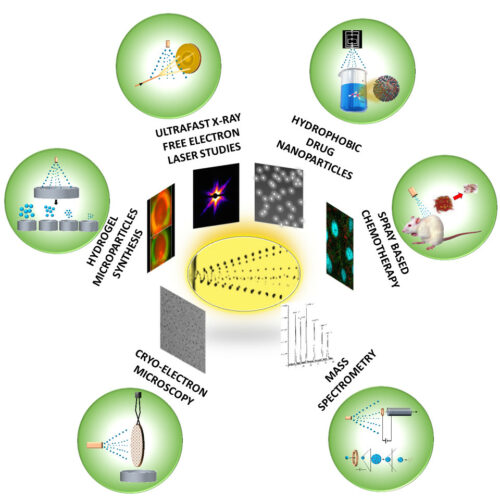Unelectrified Aerosol-Producing Device for Biological Studies
01/18/2023

A new “whipping jet” device delivers precisely controlled two-dimensional microdroplets. Potential applications in basic and applied research include ultrafast X-ray free electron laser studies, hydrophobic drug nanoparticles, spray-based chemotherapies, mass spectrometry, cryo-electron microscopy, hydrogel microparticles synthesis, and others. [Reprinted from Cell Reports Physical Science, 4(1), Narayanasamy et al., A sui generis whipping instability based self-sequencing multi-monodisperse 2D Sprays from an anisotropic microfluidic liquid jet device, Article No. 101221, Copyright 2023, with permission from Elsevier.]
The Summary

The “whipping jet” device delivers a highly reproducible two-dimensional array of droplets of various sizes using a fine-scale microfluidic nozzle. [Reprinted from Narayanasamy et al., Copyright 2023, with permission from Elsevier.]
The novel device has the potential to impact many fields of basic and applied research including structural biology, carbon capture, and climate science. Microdroplet production can also benefit sample environment instrumentation such as mass spectrometry, X-ray free-electron lasers (XFELs), synchrotrons, and cryo-electron microscopy (cryo-EM) used in, for example, biomacromolecule characterization.
Funding
This work has been supported by the Cluster of Excellence “The Hamburg Center for Ultrafast Imaging – Structure, Dynamics and Control of Matter at the Atomic Scale” of the Deutsche Forschungsgemeinschaft (CUI, DFG-EXC1074, project ID 194651731). This work was conducted through the Berkeley Synchrotron Infrared Structural Biology (BSISB) Imaging program, supported by the U.S. Department of Energy, Office of Biological and Environmental Research, under contract no. DE-AC02-05CH11231. This work was performed under the auspices of the U.S. Department of Energy by Lawrence Livermore National Laboratory under contract DE-AC52-07NA27344. The authors would like to acknowledge the cleanroom facility provided by the Center for Free-Electron Laser Science (CFEL) at Deutsches Elektronen-Synchrotron (DESY).
Related Links
- BER Resource: Berkeley Synchrotron Infrared Structural Biology
- BSISB News: Aerosol ‘Whipping Jet’ Technology Is First of Its Kind
- LBNL News: Whip It: Novel Liquid Jet Makes Droplets March to the Beat
- VIDEO
References
Narayanasamy et al. 2023. A sui generis whipping instability based self-sequencing multi-monodisperse 2D Sprays from an anisotropic microfluidic liquid jet device. Cell Reports Physical Science, 4(1), 101221. [DOI: 10.1016/j.xcrp.2022.101221]
